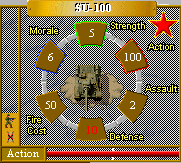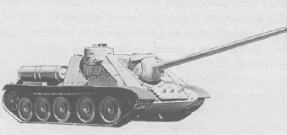
|
| Victory Points |
Armour | Start | Start | End | End | ||
| Front | Side | Rear | Month | Year | Month | Year | |
| 6 | 11 | 7 | 7 | 11 | 44 | 5 | 45 |
| SU-100 Medium Mechanized Gun | ||||||||||||||||||||
| RANGE | 1 | 2 | 3 | 4 | 5 | 6 | 7 | 8 | 9 | 10 | 11 | 12 | 13 | 14 | 15 | 16 | 17 | 18 | 19 | 20 |
| HARD | 46 | 42 | 38 | 34 | 30 | 26 | 20 | 16 | . | . | . | . | . | . | . | . | . | . | . | . |
| SOFT | 15 | 15 | 14 | 14 | 13 | 13 | 12 | 11 | 10 | 9 | 8 | 8 | 7 | 7 | 6 | 6 | . | . | . | . |

|
SU-100 Medium Mechanized Gun
|
Specification |
|
Replacing the SU-85 in production from mid-1944 the SU-100 was identical except for its long 100 mm (3.94 in) gun developed from a high-velocity naval gun with a formidable armour penetration performance.A raised cupola provided all-round vision devices for the commander. It was a formidable tank-killer even against the German Panthers and Tigers and remained in service with most Warsaw Pact armies until the 1960s and with other Soviet-influenced armed forces as late as the 1980s.Israeli tank crew encountered them in the campaigns of both 1956 and 1967. Although intended primarily for destroying tanks the 100 mm gun could also fire a useful high explosive shell.As with the SU-85 there were no secondary machine gun armament so close combat had to be avoided.One practice which was adopted as a standard was to bolt spare track links over the front hull and superstructure sides to increase armour protection. A tactical limitation for the SU-100 was that the internal ammunition stowage was limited by the length of the one-piece rounds involved.The SU-100 could accommodate only 34 100mm rounds on racks around the fighting compartment walls , compared to the 48 85 mm rounds on the SU-85.This was often alleviated by carring ammunition in cases stowed on the rear hull but this was not a practice to be encouraged during combat.It was bad enough that the SU-100s carried external fuel tanks. |
